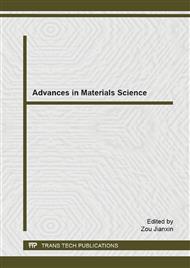[1]
1 E. Tütem, R. Apak, C.F. Unal, Adsorptive removal of chlorophenols from water by bituminous shale, Water Res. 32 (1998) 2315-2324.
DOI: 10.1016/s0043-1354(97)00476-4
Google Scholar
[2]
2 J.P. Wang, H.M. Feng, H.Q. Yu, Analysis of adsorption characteristics of 2, 4-dichlorophenol from aqueous solutions by activated carbon fiber, J. Hazard. Mater. 144 (2007) 200-207.
DOI: 10.1016/j.jhazmat.2006.10.003
Google Scholar
[3]
3 C.F. Hou, X.P. Ge, Y.M. Zhou, et al. Characterization of nanoscale iron and its degradation of 2, 4-dichlorophenol, Chin. Sci. Bull. 55 (2010) 350-357.
DOI: 10.1007/s11434-009-0676-3
Google Scholar
[4]
H.Y. Gu, X.W. Zhang , Z.J. Li, et al. Studies on treatment of chlorophenol-containing wastewater by microbial fuel cell, Chin. Sci. Bull. 52 (2007) 3448-3451.
DOI: 10.1007/s11434-007-0503-7
Google Scholar
[5]
R. Jain, M. Mathur, S. Sikarwar, et al. Removal of the hazardous dye rhodamine B through photocatalytic and adsorption treatments, J. Environ. Manage. 85 (2007) 956-964.
DOI: 10.1016/j.jenvman.2006.11.002
Google Scholar
[6]
B. Toledo, J.R. Utrilla, M.A.F. Garcia, et al. Influence of the oxygen surface complexes of activated carbons on the adsorption of chromium ions from aqueous solutions: effect of sodium chloride and humic acid, Carbon 32 (1994) 93-100.
DOI: 10.1016/0008-6223(94)90013-2
Google Scholar
[7]
N. Calace, E. Nardi, B.M. Petronio, et al. Adsorption of phenols by papermill sludges, Environ. Pollut. 118 (2002) 315-319.
DOI: 10.1016/s0269-7491(01)00303-7
Google Scholar
[8]
I.A.W. Tan, A.L. Ahmad, B.H. Hameed, Preparation of activated carbon from coconut husk: Optimization study on removal of 2, 4, 6-trichlorophenol using response surface methodology, J. Hazard. Mater. 153 (2008) 709-717.
DOI: 10.1016/j.jhazmat.2007.09.014
Google Scholar
[9]
Z. Aksu, J. Yener, A comparative adsorption/biosorption study of monochlorinated phenols onto various sorbents, Waste Manage. 21 (2001) 695-702.
DOI: 10.1016/s0956-053x(01)00006-x
Google Scholar
[10]
L.C. Morais, O.M. Freitas, E.P. Gonçalves, et al. Reactive dyes removal from wastewaters by adsorption on eucalyptus bark: variables that define the process, Water Res. 33 (1999) 979-988.
DOI: 10.1016/s0043-1354(98)00294-2
Google Scholar
[11]
K.S. Low, C.K. Lee, Quaternized rice husk as sorbent for reactive dyes, Bioresour. Technol. 61 (1997) 121-125.
DOI: 10.1016/s0960-8524(97)00054-0
Google Scholar
[12]
M.H. Zhou, Q.Z. Dai, L.C. Lei, et al. Activated carbon adsorption-advanced electro-oxidative regeneration for the treatment of biorefractory organic pollutants, Chin. Sci. Bull. 50 (2005) 489-491. [DOI: 10. 1360/982004-470].
DOI: 10.1360/982004-470
Google Scholar
[13]
V.K. Garg, R. Kumar, R. Gupta, Removal of malachite green dye from aqueous solution by adsorption using agro-industry waste: a case study of Prosopis cineraria, Dyes Pigments. 62 (2004) 1-10.
DOI: 10.1016/j.dyepig.2003.10.016
Google Scholar
[14]
M. Radhika, K. Palanivelu, Adsorptive removal of chlorophenols from aqueous solution by low cost adsorbent-Kinetics and isotherm analysis, J. Hazard. Mater. B138 (2006) 116-124.
DOI: 10.1016/j.jhazmat.2006.05.045
Google Scholar
[15]
K. Kadirvelu, C. Karthika, N. Vennilamani, et al. Activated carbon from industrial solid waste as an adsorbent for the removal of Rhodamine-B from aqueous solution: Kinetic and equilibrium studies, Chemosphere 60 (2005) 1009-1017.
DOI: 10.1016/j.chemosphere.2005.01.047
Google Scholar
[16]
M.V. Sureshkumar, C. Namasivayam, Adsorption behavior of Direct Red 12B and Rhodamine B from water onto surfactant-modified coconut coir pith, Colloids and Surfaces A: Physicochem. Eng. Aspects. 317 (2008) 277-283.
DOI: 10.1016/j.colsurfa.2007.10.026
Google Scholar
[17]
O. Hamdaoui, Batch study of liquid-phase adsorption of methylene blue using cedar sawdust and crushed brick, J. Hazard. Mater. B135 (2006) 264-273.
DOI: 10.1016/j.jhazmat.2005.11.062
Google Scholar


